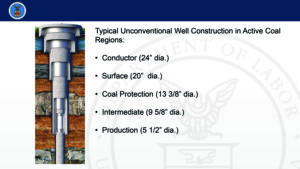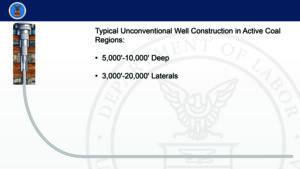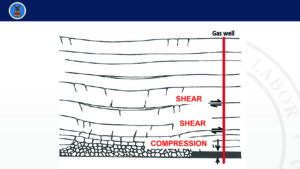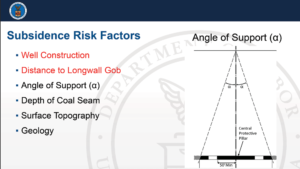
It’s important for underground coal operators to understand how the wells are constructed. (Source: MSHA)
Considerations for the design of protective barriers around gas well
Coal operators and gas drillers provide energy from similar horizons, and they have had to learn to coexist for more than 100 years. In 1914, a group of coal and oil-and-gas operators decided that they needed to come up with a solution as to how they were going to co-exist. At the time, George Rice, the chief engineer from the U.S. Bureau of Mines, said, “Undoubtedly, there’s a serious problem through the juxtaposition of gas and oil wells and coal mines, not only now, but into the future.” That future is today, said Greg Rumbaugh, P.E., supervisory engineer for the Mine Safety and Health Administration’s Roof Control Division.
In a presentation he delivered at the U.S. Coal Show, Barriers and Mining-Induced Ground Movements Near Gas Wells, Rumbaugh talked about how the two industries have evolved and what mine operators need to consider to protect their operations from possible gas breaches.
Gas drillers have transitioned from conventional wells, which are relatively shallow, vertical wells, to unconventional wells that are deeper and provide higher volumes of gas. The costs for these wells can range anywhere from $7 million to $10 million per well, and once installed, they are very difficult to take offline.
Approximately 1,000 to 2,000 wells are being drilled every year in northern Appalachia. “The operators installing these wells intend to keep them online longer,” Rumbaugh said. “The gas flows are high, and they produce more gas over time. In 2009, laterals were 300- to 500-ft long, and now they are about four or five times that length. These wells are also deeper with higher pressures.” Rumbaugh wants mine operators to understand the possible hazards if these wells were breached into a mine’s atmosphere.
The 57 Study
The last time there was a major study on this subject was 1957, Rumbaugh explained. “No matter where you go, Kentucky, West Virginia, Illinois and especially Pennsylvania, people refer to the 57 study,” he said. “They will say we determined our barriers based on the 57 study.”
A lot has changed since 1957. “This study was based on 77 gas wells that were evaluated when they were near retreat mining between 1920s and the 1950s,” Rumbaugh said. “So, we’re talking about different mining methods. It wasn’t full extraction longwall mining. The maximum depth in the 57 case study was about 650 ft. We are operating twice as deep today.”

Today’s gas wells are deep and the laterals are long. (Source: MSHA)
Rumbaugh also pointed out that nowhere in the 57 study does it talk about miner safety. The intent of the 57 study was to enable two industries to coexist so that mining did not permanently damage the gas well. “The criteria for failure in that study is when did the gas well stop producing; it wasn’t when did the well breach gas into the mine atmosphere,” Rumbaugh said.
The coal industry, however, implemented the recommendations very quickly and they remain in practice today. Mine maps from the 1950s show active gas wells with 50-foot protective barriers from retreat mining. There is also evidence that miners followed the protocol for dry holes as well.
Just as the gas industry changed so too has coal mining methods. Mines today achieve complete extraction of large longwall panels adjacent to gas wells. Retreat mining in the 1950s did not achieve full extraction. At that time, timbers and coal pillars were the only supports, and they continued to provide some level of ground support after active mining ceased.
Most longwall operators think of subsidence as a vertical component, Rumbaugh explained, but there’s are other forces exerted on the surrounding geology. The forces go unnoticed to the longwall miner, but the gas wells are impacted by shear and compression forces that are exerted near the seam elevation. “A gas well within a protective pillar could be damaged as that pillar compresses,” Rumbaugh said. “Bedding plane shift or horizontal slip also occurs between very strong and soft layers, especially in the Uniontown and Sewickley coal seams. That bedding plane slip also causes shear on the gas wells.”
The hazard has been identified by recent pressure tests on wells adjacent to longwall mining. Drillers plugged the well as the longwall passed. “While they we’re attempting to re-enter, the well pressure was charged, and it immediately bled off in 20 to 30 minutes,” Rumbaugh said. “They attempted it again and it bled off in 20 to 30 minutes. That tells us that somewhere between the surface and the coal seam, that well structure was breached into the surrounding strata.”
Factors to Consider for Protective Pillars
There are several factors mine operators should consider to help assess whether longwall mining is going to have an impact on a nearby shale well; these include:
Well construction;
Distance to the longwall gob;
Angle of support (α);
Depth of coal seam;
Surface topographic location; and
Geology.

Longwall mining exerts forces on the drill string and the barrier pillar. (Source: MSHA)
For the last 10 years, the industry has been focused on well construction and designing these wells to accept some level of deformation. Gas producers often tout the fact that the casings are all fully grouted to the surface. “With fully grouted well casings, we are finding that shifts in the overburden have an impact on that well, particularly on the production string, that is an order magnitude higher than if the drillers had left the annulus around the production strings empty,” Rumbaugh said.
The construction records for these gas wells are critical. “If there is active drilling taking place on your reserves, it is absolutely critical to make sure the gas well operator is recording exactly how those wells are being constructed,” Rumbaugh said. “Three times over the last two years, we’ve seen well records that say one thing, and then we find that the casing might be different, or the grout around the production string is different. So, we need to make sure that the information that you’re using for assessing the risk is accurate.”
The closer the well is to the longwall gob, the more it will experience deformation.
The 57 study has some relevant points, Rumbaugh explained, and one of them is the Angle of Support. “Once the tangent of 8° was achieved underground at that barrier distance, those wells did not experience any potential failure,” Rumbaugh said. “So the Angle of Support is one factor in what we recommend evaluating for those risks.”
Shallow wells often experiene higher degrees of deformation than deeper wells. “That might seem counterintuitive, but with deeper coal seams, subsidence, the cave, the fracturing and the slip is controlled by the confinement that’s available to mobilize or de-mobilize those bedding planes,” Rumbaugh said. “We often see higher degrees of bedding plane slip at more shallow depths.”
The new ACPS software that’s available on the University of Kentucky website allows users to model all kinds of different geometries, Rumbaugh explained. “We’ve used it in all kinds of different configurations to be able to look at system stability for protective gas well pillars,” Rumbaugh said. “The recommended criteria, as with any long-term application, is a 2.0 stability factor for the barriers.”
Considering the compression forces, Rumbaugh also said the barrier should be designed as a squat pillar, “one that will continue to accept load with little deformation at the center of that pillar,” he said. “Ideally, it would be a wide, protective pillar with height-to-width ratios greater than 12.”

The Angle of Support is an important consideration for barrier pillar design. (Source: MSHA)
When it comes to protective pillar design, he said the MSHA Ground Control Division collaborates with the MSHA Ventilation and Technical Support divisions, as well as NIOSH researchers. “There’s a lot of other things that we’ve learned along the way,” Rumbaugh said.
Some of the other barrier considerations (even if Marcellus is plugged) include gas sources other than the producing reservoir and well construction information. “There are many sources of gas that exist other than just the producing zone,” Rumbaugh said. “There can be anywhere from a dozen to 20 different gas-producing zones that might exist beneath these intermediate basins. In the next two to three years, most of the longwall mines in northern Appalachia will have at least one underground storage field that they’re operating above.
“We have also seen a lot of wells with annular pressure that lie outside of the production string,” he said. “If you’re evaluating the risk of a gas well, even if it’s going to be temporarily plugged, it’s also worthwhile to understand the source of any gas that’s in the annulus of these other casings. That gas might be present outside of the production string.”
Rumbaugh said what surprises him is how different well construction could be even on the same pad. “You can’t look at just one well and think that it represents the construction of every well on the pad,” Rumbaugh said. “We’ve seen wells with different depths of casing. We’ve seen cases where the grout is completely different on an adjacent gas well. Don’t look at one well on a pad and assume that that well construction is uniform across all the others.”
The mining industry in 2023 has a lot of unique challenges to solve that many generations before didn’t have to think about in terms of the magnitude of what could happen, Rumbaugh said, but these are not new problems. These industries have co-existed for more than 100 years, and they have done so safely in most cases.




